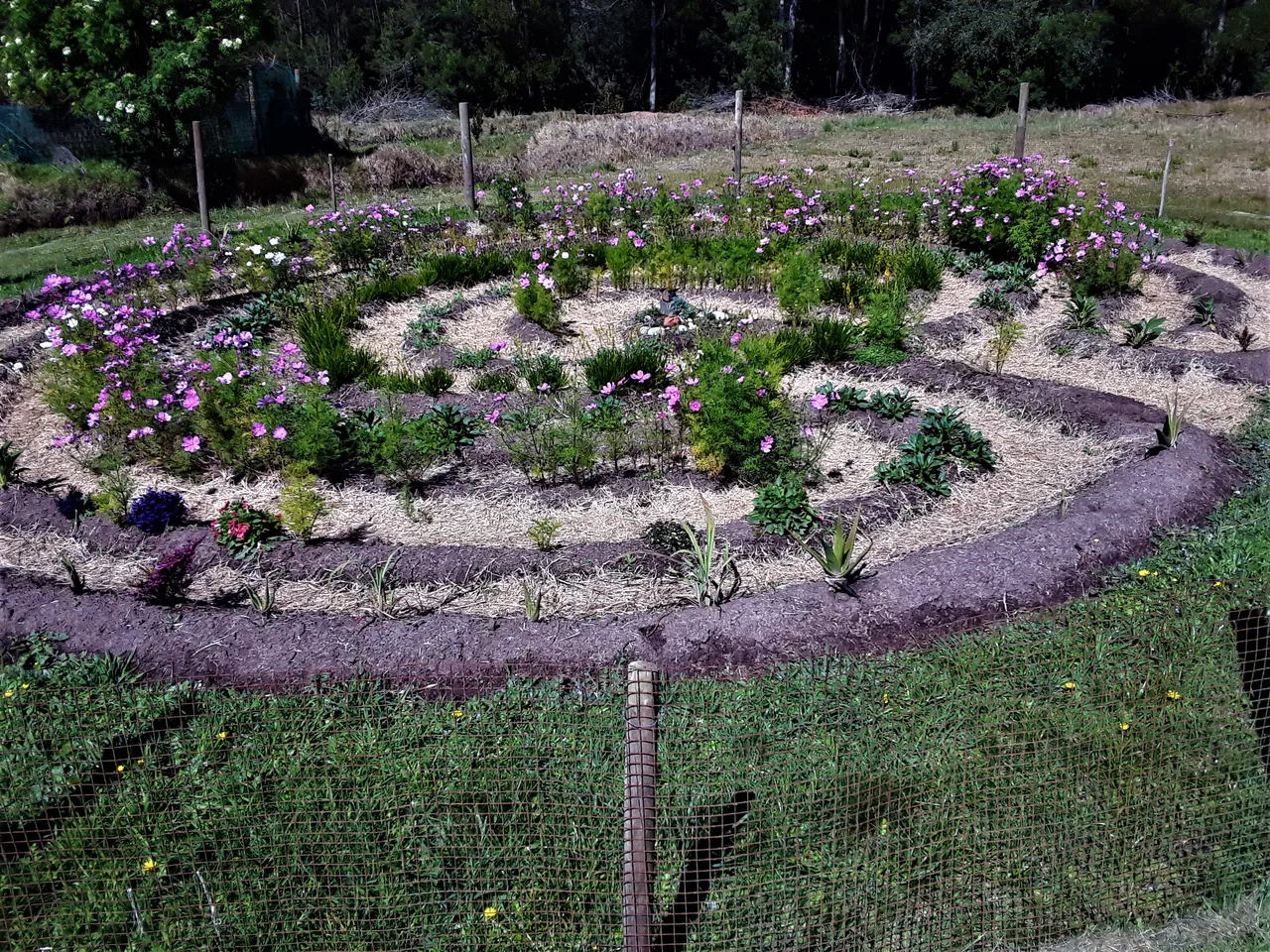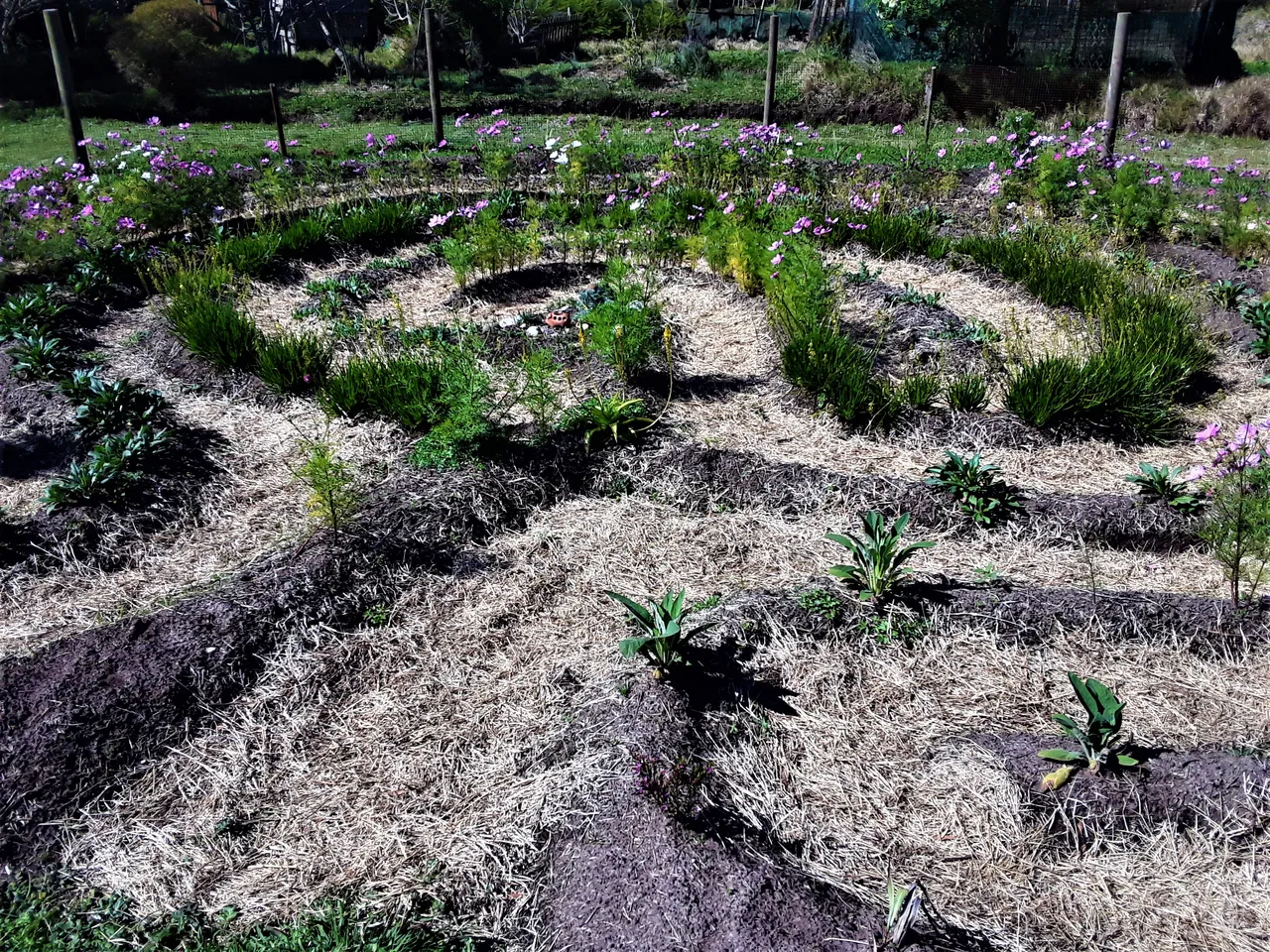Here is a labyrinth made entirely out of garden landscaping. It was designed by some friends who live nearby. They plotted the pattern out on the ground and then worked on sculpting it one step at a time. If walking the labyrinth is a meditation, then so is constructing one. And so life becomes one long meditative process. Zen and the art of gardening perhaps.

By first plotting the paths of the labyrinth, they were able to then clear out the earth to make the actual paths and walls, so to speak. They decided to make it a medicinal labyrinth, where numerous healing plants would make up the walls of the pathways itself. Here in the photos I took recently, you can see some of the early plants manifesting.
It still has some growing to do, but the overall structure is complete and we walk the labyrinth most times when I go visit them. You can see how the pathways have been filled with mulch. This is a permaculture technique, where less is more, in the sense that you can work less and achieve more if you simply use nature’s energy in a well harnessed way, going with the flow, so to speak.
By merely covering the pathways with freshly cut grass, for example, they paths remain clear of growth while the walls of the paths are sculpted into slightly raised beds for the plants. When it rains, water collects in the paths under the mulch and is able to drain in and feed the plant life along the walls.

Permaculture also recommends planting along the edges so that you can more easily access your harvest. And naturally a labyrinth is nothing but edges, so there is an increased area to plant upon. In this way many goals are achieved in one project. Medicinal plants and flowers are cultivated, a picturesque circular garden is manifested and also a meditative labyrinth is now fully functional for us to do a walking meditation.
Walking the labyrinth takes a few minutes and it leads the walker gradually to the center. So it provides a sense of going within, or becoming centered, as you do the winding circular journey. At the center is a nice little statue of the Buddha, where one can sit and contemplate the divinity within the center of oneself, or in the region of the heart.
There one can sit and meditate still further on the deity, or offer some prayers or simply be still and present in the moment, at the peaceful still center point. Then we walk the journey back outward once more. In itself it’s a valuable tool for calming and focusing the mind. And on the walk we pass by all the numerous healing plants and lovely flowers as they bloom throughout the year.
If you have a garden or some space, you could make one for yourself at home. Traditionally they would be found in churches I presume, or sacred places of worship and pilgrimage. Walking the labyrinth could be seen as a pilgrimage in itself, a journey to the heart or to the sacred center of our life, around which everything else permeates. By placing your spiritual goal in the center of your daily lifestyle, you can keep a decent perspective of your priorities. And tending the labyrinth garden is like tending the consciousness, or the heart space.
It’s good to take out the weeds or bad habits and qualities that may pop up sometimes, while simultaneously cultivating the healing medicinal plants that will protect and empower us on the journey. All the activity around the labyrinth becomes much like a meditation or a small token spiritually focused practice, where we can leave behind the mundane distractions of life and enter a kind of sacred space of our own making.
The symbolism works very well to focus the mind, and labyrinths have been used for probably thousands of years. Curiously the shape is much like the folds of the brain tissue in the skull, all wrapped up and overlaid, to make a compact shape, full of cerebral matter. And the center could be an analogy for the pineal gland, which sits at the very center of our brains. It was named by the philosopher Rene Descartes as the “seat of the soul”.
Curiously the pineal gland appears to be the source of our spiritual life (along with the heart) via the release of the appropriate brain chemicals like DMT, that activate higher consciousness among other things. So the labyrinth is not a random shape or design but a powerful mandala of sorts, and a meditation wheel for those who wish to go within, to center themselves and attain a focus upon the still point where magic can happen.
It’s amazing how we can create our own sacred space if we choose, and do all our meditation and soul work right where we are, if it’s impossible to go to a temple or other sacred space or place of pilgrimage. We simply set the intention and create our own, wherever we may find ourselves. After all, the goal is within, the deity of divinity is within us already. We merely use these external tools to draw our focus inward upon that goal, by excluding the outer distractions and symbolically making the journey to the center.
I love going to walk the labyrinth at different times throughout the year as the flowers are constantly changing with the seasons. What a magical space to enter the mystery of life, right in your own back yard. You can certainly design one for yourself, by obtaining the pattern, laying out the initial design on the ground and then landscaping the garden around it. The entire process and the result will all be a beautiful meditation in itself, and something to help keep the focus on the goal.
(photos my own)